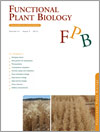
Functional Plant Biology
Volume 41 Number 2 2014
FP13177Plot size matters: interference from intergenotypic competition in plant phenotyping studies
Plot size and type are crucial considerations in the design of plant phenotyping experiments targeting growth and yield. We surveyed studies across both well-watered and water-limited environments to demonstrate how ranking can change for grain yield across wheat genotypes depending on whether hills, rows or plots are sampled. The work confirms the potential for competition and the need for assessment in larger, bordered plots particularly where genotypes are phenotypically diverse and resources such as light, water or nutrients needed for growth are limiting.
FP13097Use of introgression lines to determine the ecophysiological basis for changes in water use efficiency and yield in California processing tomatoes
Since the 1960s, processing tomato yields and agronomic water use efficiency have increased by >50%. Some tomato introgression lines differ in a small genetic region that affects determinate growth habit and the presence of leaf vein chloroplasts. This study shows that a suite of morphological and physiological traits (e.g. smaller canopies and leaf gas exchange traits) were relevant to crop improvement, and highlights the importance of trait associations to overcome potential environmental constraints.
FP13103Manipulation of methyl jasmonate esterase activity renders tomato more susceptible to Sclerotinia sclerotiorum
The phytohormone jasmonic acid has important functions in development and stress responses. The aim of this work was to shed light on the role of the conversion of methyl jasmonate to jasmonic acid. Manipulation of the methyl jasmonate hydrolysing enzyme in tomato plants results in enhanced susceptibility to the necrotrophic fungus Sclerotinia sclerotiorum. However, this sensitivity is not related to the methyl jasmonate esterase activity.
FP13134Regulation of the chloroplastic copper chaperone (CCS) and cuprozinc superoxide dismutase (CSD2) by alternative splicing and copper excess in Glycine max
Copper (Cu2+/Cu+) is an essential micronutrient for all living organisms. Both deficiency and excess can cause severe nutritional and environmental damages. In the present work we studied the regulation of gene and protein expressions of two important cuproproteins, CCS and CSD2, in soybean under environmental copper excess. The obtained results allow a better understanding of the copper homeostasis in higher plants.
FP12393Manganese toxicity and UV-B radiation differentially influence the physiology and biochemistry of highbush blueberry (Vaccinium corymbosum) cultivars
Antioxidative mechanisms of Vaccinium corymbosum cultivars under toxic Mn2+ and UV-B radiation were characterised. Mn2+ toxicity combined with UV-B radiation had a more negative effect on growth and the performance of the photosynthetic apparatus in the cultivar Bluegold than in Brigitta. Increased activation of the antioxidative and photoprotective mechanisms was the basis for increased resistance to these stresses in Brigitta compared with Bluegold.
FP13054Rapid adjustment of leaf angle explains how the desert moss, Syntrichia caninervis, copes with multiple resource limitations during rehydration
Desert mosses capture and utilise moisture from brief precipitation events such as dew, fog and short-term rain showers. Syntrichia caninervis can rapidly vary the angle of leaf to the stem to gain maximum photosynthetic advantage in the shortest possible time after wetting, utilising complex microtopography of leaves and leaf hair points, anatomical structures and ultrastructure mechanisms to facilitate this process. Although small and often overlooked, desert mosses play an important role in carbon sequestration in inhospitable environments unsuitable for colonisation by vascular plants.
FP13160Water redistribution determines photosynthetic responses to warming and drying in two polar mosses
To understand and predict the effects of climate change on organisms requires the disentangling of the effects of temperature and humidity (which can change with temperature). By carefully controlling air moisture as well as temperature we showed that Antarctic mosses are not affected by a wide range of temperatures, but instead respond strongly to humidity. This finding is crucial to making accurate prediction of how polar vegetation (in which mosses often dominate) will respond to current and future climate changes.
FP13178Effects of organic acids on the formation of the barrier to radial oxygen loss in roots of Hordeum marinum
Barriers to radial oxygen loss in the outer zones of roots are an important adaptation of many wetland plants growing in waterlogged, anaerobic soils; however, the signal(s) involved in its formation require elucidation. Organic acids, compounds produced by microorganisms in waterlogged soils, promoted root barrier formation but also had detrimental effects on root growth and tissue potassium status. Tolerance to organic acid toxicity would contribute to waterlogging tolerance in plants.
FP13106Co-expression of xerophyte Zygophyllum xanthoxylum ZxNHX and ZxVP1-1 enhances salt and drought tolerance in transgenic Lotus corniculatus by increasing cations accumulation
Overexpressing genes involved in ion compartmentalisation can improve the salt and drought tolerance of plants, but the effectiveness of those homologous genes from xerophytes is not clear. The aim of this study was to improve the stress tolerance of Lotus corniculatus by expressing tonoplast Na+/H+ antiporter and H+-PPase from the xerophyte Zygophyllum xanthoxylum: the transgenic lines showed enhanced salt and drought tolerance. Results suggest it is feasible to use functional genes of compartmentalisation from xerophytes in genetic engineering for plant stress tolerance.
FP13143Wheat genotypes with high early vigour accumulate more nitrogen and have higher photosynthetic nitrogen use efficiency during early growth
Improved nitrogen (N) uptake and N use efficiency of wheat could significantly reduce N fertiliser input and N losses through leaching. Large genetic variation was found for shoot biomass and N uptake among 24 wheat genotypes. The utilisation of genotypes with high early vigour could improve the efficiency of N use for biomass production and N uptake during early growth.




